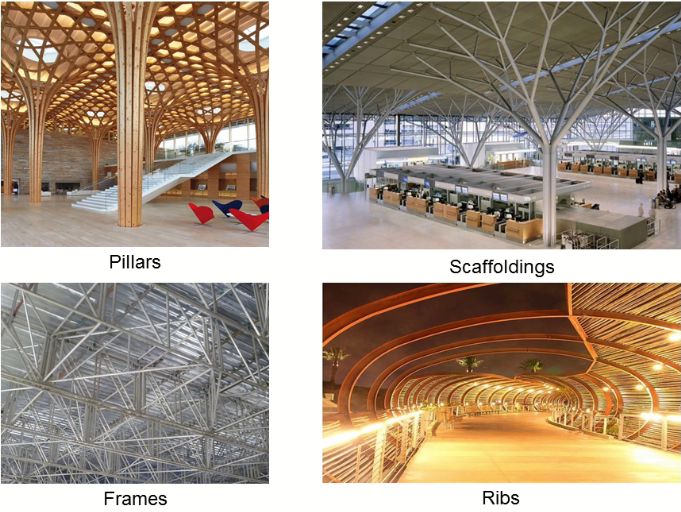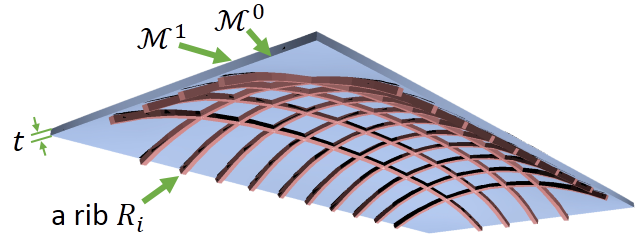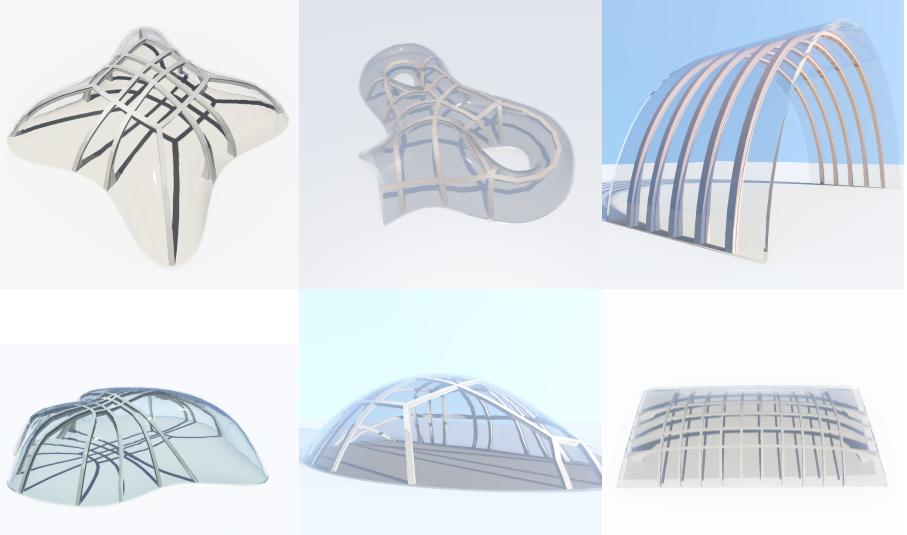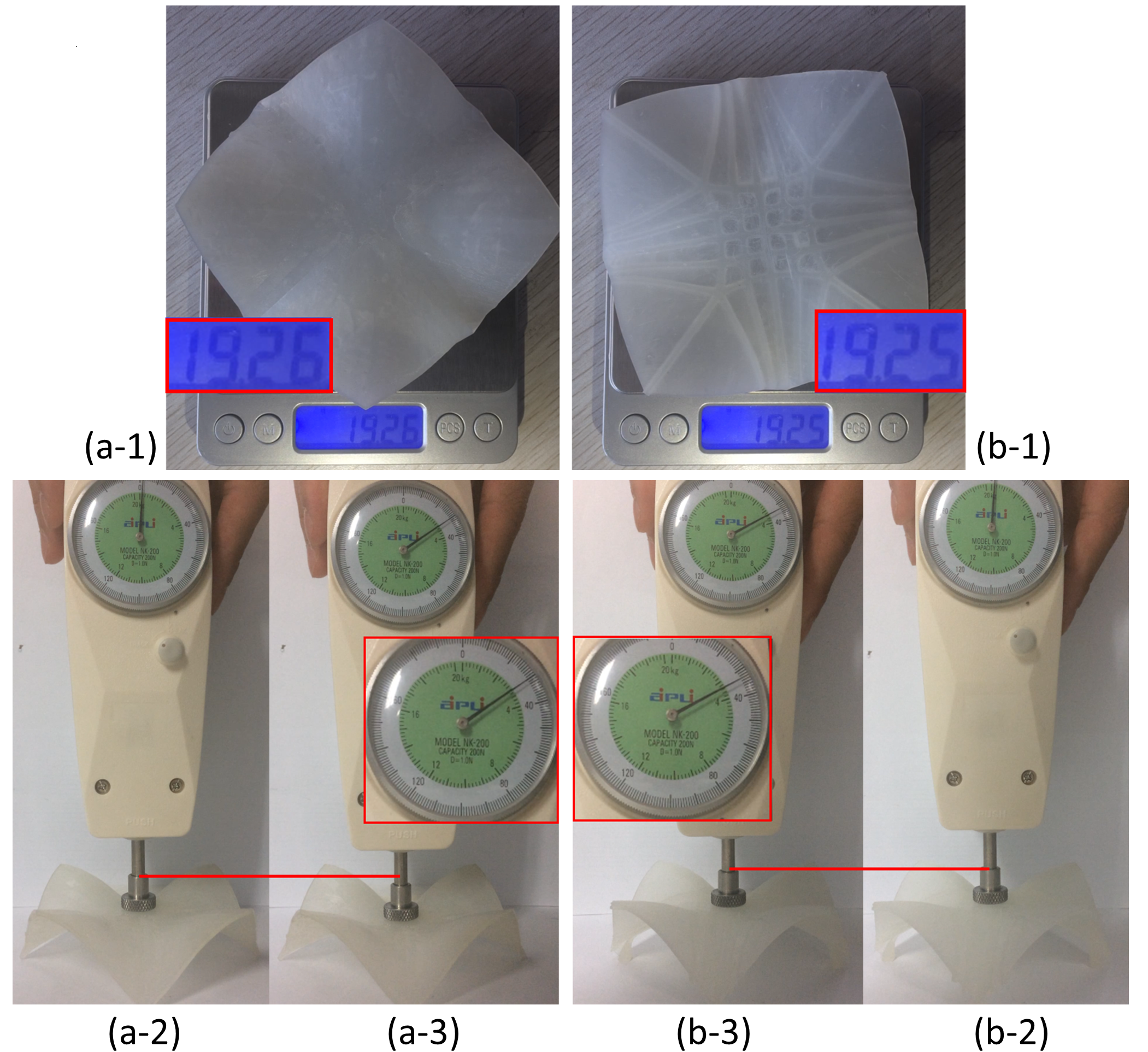|
Rib-reinforced Shell Structure
Computer Graphics Forum 2017
|
|||||||
|
|
|||||||
|
Teaser: We present a computational framework to generate ribs to enhance the structural strength and stiffness of a shell (a). Our ribreinforced shell structure (c) costs the same amount of material as a pure shell without any ribs (a), while achieving much better mechanical performance. And (b) and (d) are coloring visualizations of the magnitude of von Mises stress of (a) and (c), respectively, under the same load and boundary conditions. Warmer color represents higher stress and red encodes stress exceeding the yield strength 42 MPa. The maximum stress in (b) is 109.84 MPa, which far exceeds 42 MPa, while the maximum stress in (d) is below 40 MPa with the contribution from ribs. The maximum stress of the shell is about 3 times of the stress of the rib-reinforced shell structure, indicating the latter achieves much higher strength than the former. We also fabricated the two structures by 3D printing and made a stiffness comparison as shown in Figure 19 in the paper which indicates much higher stiffness of the rib-reinforced shell structure.
|
|||||||
| Abstract |
Shell structures are extensively used in engineering due to their efficient load-carrying capacity relative to material volume. However, large-span shells require additional supporting structures to strengthen fragile regions. The problem of designing optimal stiffeners is therefore becoming a major challenge for shell applications. To address it, we propose a computational framework to design and optimize rib layout on arbitrary shell to improve the overall structural stiffness and mechanical performance. The essential of our method is to place ribs along the principal stress lines which reflect paths of material continuity and indicates trajectories of internal forces. Given a surface and user-specified external loads, we perform a Finite Element Analysis. Using the resulting principal stress field, we generate a quad-mesh whose edges align with this cross field. Then we extract an initial rib network from the quad-mesh. After simplifying rib network by removing ribs with little contribution, we perform a rib flow optimization which allows ribs to swing on surface to further adjust rib distribution. Finally, we optimize rib cross-section to maximally reduce material usage while achieving certain structural stiffness requirements. We demonstrate that our rib-reinforced shell structures achieve good static performances. And experimental results by 3D printed objects show the effectiveness of our method.
|
||||||
| Keywords |
Architectural geometry, Rib-shell structure, Principal stress
|
||||||
| Motivation |
Shell structures are extensively used in engineering due to their efficient load-carrying capacity relative to material volume. However, large-span shells require additional supporting structures, like pillars, scaffoldings, frames or ribs, to strengthen fragile regions. Among these stiffners, ribs have unique advantages. Firstly, ribs don’t occupy too much internal space compared with pillars, scaffoldings or frames. Secondly, ribs utilize the bending characteristics, so they avoid stress concentration and have better stability, while pillars, scaffoldings and frames may cause buckling under different loads. Finally, ribs can have variable cross-sectional shapes which achieve different performance and meet kind of goals. |
||||||
| Concept |
Rib-shell structure consists of a thin shell and some ribs, with each rib closely attached to one or both sides of the shell. |
||||||
| Method |
Given an input surface (a), we first generate a dense rib network (b), followed by a simplification process to remove the ribs with little contribution (c). Then we perform a rib flow optimization to adjust the layout of ribs (d). Finally we optimize the cross-section of ribs using hyperelliptic T-section (e). |
||||||
| Results |
Rib-shell structures generated by our system, including Lilium, Aquadom, Bridge, Botanic, Snail and Neumunster.
The fabricated shell (a-1) and rib-reinforced shell (b-1) cost about the same amount of materials (19.26g for the former and 19.25g for the latter). When imposing loads at the center, the pure shell has a displacement of 5.6mm under a 30N load (a-3), while the displacement is 1.2mm for the rib-reinforced shell under a 33N load (b-3). And (a-2) and (b-2) are initial states without load for reference. |
||||||
| Paper |
high-res PDF (~16M)
|
||||||
| Video |
Demo (*.mp4) (103M)
|
||||||
| Ack |
We would first like to thank the reviewers for the valuable comments. Also, we would especially like to thank Chi-Han Peng and Peter Wonka for providing the code of [PZKW11]. This work is supported by the National Natural Science Foundation of China (61672482, 11626253), the One Hundred Talent Project of the Chinese Academy of Sciences, EU Horizon 2020 RISE 2017 PDE-GIR project 778035, the FP7 European project Dr Inventor FP7-611383, EU H2020 funded project AniAge (H2020-MSCA-RISE-691215) and EU FP7 funded project AniNex (FP7-IRSES-612627).
|
||||||
| BibTex |
@article {Li:PG2017, title = {Rib-reinforced Shell Structure}, author = {Wei Li, Anzong Zheng, Lihua You, Xiaosong Yang, Jianjun Zhang and Ligang Liu} journal = {Computer Graphics Forum (Proc. Pacific Graphics)}, volume={36}, number={7}, year = {2017} } |
||||||
|
|
|||||||
|
|
|||||||
| Copyright and disclaimer: The SOFTWARE provided at this page is provided "as is", without any guarantee made as to its suitability or fitness for any particular use. It may contain bugs, so use of this tool is at your own risk. We take no responsibility for any damage that may unintentionally be caused through its use. |
| Copyright © 2017 GCL , USTC |





